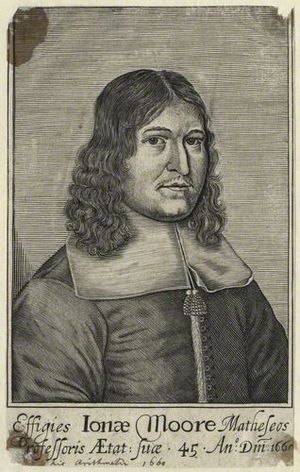Jonas Moore facts for kids
Quick facts for kids
Jonas Moore
|
|
|---|---|

Engraved portrait of Moore by an unknown artist
|
|
| Born | 1617 Higham, Lancashire
|
| Died | 27 August 1679 |
| Nationality | British |
| Awards | Fellow of the Royal Society |
| Scientific career | |
| Fields | mathematician, surveyor |
| Institutions | East Anglia; Royal Observatory, Greenwich |
Sir Jonas Moore (1617–1679) was an important English mathematician and surveyor. He helped with big building projects in the 1600s. He also played a key role in starting the Royal Observatory in Greenwich.
Contents
Early Life and Beginnings
Jonas Moore was born on February 8, 1617, in Higham, England. His family were farmers. We don't know much about his early schooling. However, he likely went to Burnley Grammar School, which was close to his home.
In 1637, Jonas got a job working for Thomas Burwell. This job needed him to be good at legal Latin. He married Eleanor Wren in 1638 and they had three children. During the English Civil War, he lost his job and had to move back to Lancashire.
Becoming a Mathematician and Surveyor
For about ten years, not much is known about Moore's life. But by 1650, he was teaching mathematics. He also published his first book, Moores Arithmetick.
In 1674, Sir Jonas Moore was the first to use the short form 'cos' for the math term cosine. That same year, he became a surveyor for a company. This company was working to drain the Fens, which are large areas of marshy land. He worked on this project for seven years.
In 1658, Moore created a huge map of the Fens. This map showed how the company had changed the landscape. It was so detailed that no other map was better until the late 1800s.
Mapping the River Thames and Tangier
In the early 1660s, Moore worked mostly as a surveyor. In 1662, he mapped the River Thames from Westminster to the sea. This was his first job for the government.
From 1663, James, Duke of York became a major supporter of Moore. In June, Moore visited Tangier (which was an English territory then). He was part of a team designing a stone pier there. When he returned, he made a map of Tangier and the Straits of Gibraltar. Samuel Pepys, a famous diarist, was very impressed with this map.
Working for the Ordnance Office
With the Duke of York's support, Moore joined the Ordnance Office. This office was in charge of military supplies. He became Assistant Surveyor of the Ordnance in 1665. Later, in 1669, he became the Surveyor-General of the Ordnance.
The Surveyor's main job was to make sure there were enough guns and ammunition. During the Third Anglo-Dutch War, Moore helped supply the navy. He was knighted in 1673, likely for his work during this war.
Supporting Astronomy
After the war ended in 1674, Moore focused on his interest in astronomy. He tried to get the Royal Society to support an observatory. He was elected to the Royal Society in December 1674. In May 1676, he became a Vice-President of the Royal Society.
When King Charles II appointed John Flamsteed as his "astronomical observator" in 1675, Flamsteed had already been supported by Moore since 1670. The Ordnance Office was responsible for building the Royal Observatory at Greenwich. It was finished in June 1676. Moore even paid for much of the Observatory's equipment himself. This included two large clocks made by Thomas Tompion.
Later Life and Legacy
Towards the end of his life, Moore became very interested in the Royal Mathematical School at Christ's Hospital in London. He became a governor there in 1676. In 1677, Moore started writing a math book called A New Systeme of the Mathematicks. He wanted it to be a math course for the school.
Sir Jonas Moore died on August 27, 1679, before finishing his book. His son, also named Jonas, took over his role. However, his son died soon after. So, the husbands of Moore's two daughters finished and published the book in 1681. John Flamsteed and Edmond Halley helped write the final parts.
Moore and his son were buried at the Church of St Peter ad Vincula in the Tower of London.
Friends and Colleagues
John Aubrey, who wrote about Moore, described him as a "good mathematician and a good fellowe." This meant he enjoyed spending time with friends. One of his friends was Samuel Pepys. Pepys wrote in his diary about their discussions.
Moore was also friends with Sir Christopher Wren and Robert Hooke. They were all connected to the Royal Observatory. Moore always wanted to see clear results from Flamsteed's work at Greenwich.

